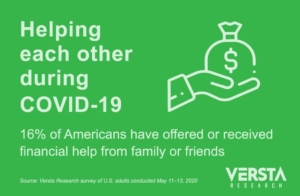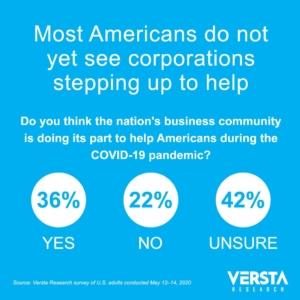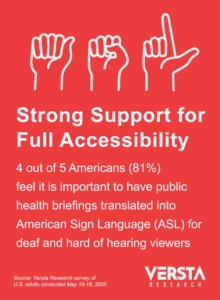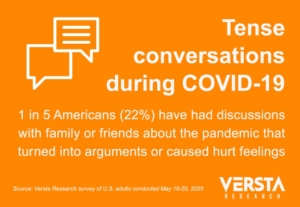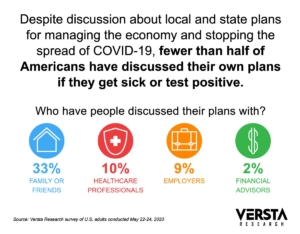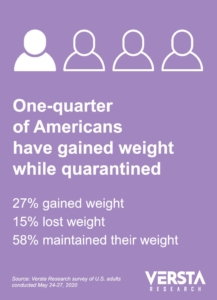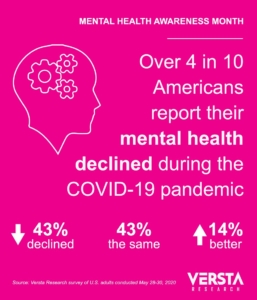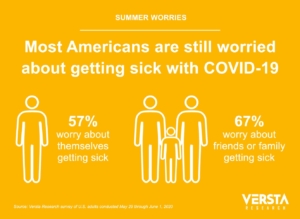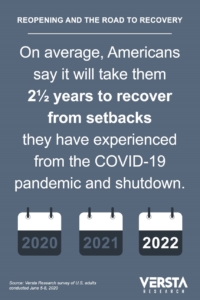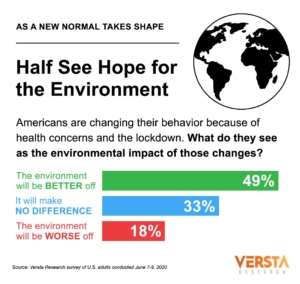
July 2020
Dear Reader,
If you need to develop super-fast, super-cheap, but still rigorous, research insights for thought leadership content, this newsletter is for you.
A feature article on How to Use Surveys for Thought Leadership on a Shoestring Budget describes a new process we used during the COVID-19 pandemic to compete against the onslaught of other trackers and surveys we were seeing in the markeplace. It is was an entirely DIY approach in which we launched a series of ten extremely fast snapshot surveys for social media over the course of four weeks. It cost just a few hundred dollars.
Other items of interest in this newsletter include:
- A Checklist for Testing Surveys
- 4 Things to Ponder Before Choosing an Omnibus Survey
- Here’s Why You Should “Punish Test” Your Surveys
- The Best New Tool for Fixing Your Research Reports
- Here’s Your Chance to Write Better Questionnaires
- Focus on Solutions in PR Surveys
- This PR Survey Is a Dream Come True. If Only It Weren’t Nonsense
- Mobile Surveys Are Better in One Surprising Way: You Get More Revealing Personal Information
- Slow Down! Your Survey’s Too Fast
- How to Download and Analyze Your Own Census Data
We are also delighted to share with you:… which showcases some of our recent work focused on mental health issues in the workplace.
As always, feel free to reach out with an inquiry or with questions you may have. We would be pleased to consult with you on your next research effort.
Happy summer,
The Versta Team
How to Use Surveys for Thought Leadership on a Shoestring Budget
High quality PR surveys for thought leadership typically take several months and thousands of dollars to execute. Ideally they start with dream headlines, then move into survey design, stakeholder input, legal approval, development of lengthy questionnaires to ensure depth, field time execution, data exploration, report layout, production of PR materials, and so on.
Can these types of surveys for thought leadership be done faster and cheaper without becoming junk? To find out, we experimented with an approach using DIY survey and sampling tools, real-time development of content, and rapid development of narrative findings for reporting and visualization.
Each survey was published within one day of data collection. The direct costs were just $255.
We launched ten extremely fast snapshot surveys about how Americans were responding to COVID-19. Each used census-matched sampling and took just five days from ideation to public release. In all, we sampled over 3,300 U.S. adults over four weeks. Each survey was published within one day of data collection. The direct costs were just $255.
The results of this effort were presented two weeks ago at the July 2020 Quirk’s Event. Here is a full video of that presentation that shows you how to execute surveys like this for your own company, using your own team, leveraging internal skills and resources. It outlines:
- Tips for developing survey questions that stand out from what competitors are doing;
- Strategies for using a DIY tool like Google Surveys (there are some surprising challenges); and
- A storytelling approach to highlight single nuggets of insight that can be shared in visually compelling formats.
Enjoy the video!
(If you are looking something specific, scroll past the video. We show all ten snapshot findings along with highlights of what we discuss in the video.)
The Snapshot Findings & Highlights
Topics discussed in “Helping Each Other” (video at 3:20):
* Get data nobody else has
* Find a positive spin
* Solicit an outside review before publishing
Topics discussed in “Corporations” (video at 5:36):
* Do not trust overnight surveys; 3 days is feasible (but difficult)
* Timing from design to publication was 5 days
* When (and when not) to use a “not sure” option
Topics discussed in “American Sign Language” (video at 8:20):
* Fast and agile lets you respond to unfolding events
* Think of ways to “give back” with content
Topics discussed in “Tense Conversations” (video at 10:05):
* You must keep the focus broad and general
* The challenge of a 100% incidence survey
* If you filter or screen, costs go up by at least 10x
Topics discussed in “Planning” (video at 12:29):
* Be creative to ask a complex question
* DIY tools have severe limitations
Topics discussed in “Weight” (video at 14:35):
* Don’t display data; tell a story
* Use charts and graphs sparingly
* If you use a chart, it must tell a story
Topics discussed in “Mental Health” (video at 16:44):
* DIY tools use Artificial Intelligence
* Design, launch and then pause so AI robots do not block you
Topics discussed in “Summer Worries” (video at 19:10):
* Ask just one question at a time
* Getting a story from just one question is hard
* If you ask more than one, costs go up by at least 10x
* If you want to ask two questions, split them onto two surveys
* The tool we used gives a 50% discount for your second survey
Topics discussed in “Time to Recovery” (video at 21:36):
* Keep things personal
* Do not ask people to predict world events
* Set context to connect with larger macro events
* Word questions so they apply to everyone
Topics discussed in “Impact on the Environment” (video at 23:39):
* If things are changing rapidly, focus on the future
* This is an example of when to use a chart
Stories from the Versta Blog
Here are several recent posts from the Versta Research Blog. Click on any headline to read more.
A Checklist for Testing Surveys
Testing a survey should involve more than running through it once or twice to make sure it looks OK. Use a checklist to navigate a more deliberate process.
4 Things to Ponder Before Choosing an Omnibus Survey
Omnibus surveys originated 50 years ago, and still might be your best option. But consider alternatives that may offer more customization at the same cost.
Here’s Why You Should “Punish Test” Your Surveys
Use checklists and rigorous testing protocols on your surveys before launching them, or else you will end up with serious mistakes that require refielding.
The Best New Tool for Fixing Your Research Reports
One trick that will hugely improve your writing (AND help you catch mistakes) is to read out loud. We recommend using the Read Aloud functionality in Office.
Here’s Your Chance to Write Better Questionnaires
Writing great surveys is not intuitive, and not an innate skill. It takes training. The Univ. of Michigan offers 3 online courses we recommend this summer.
Focus on Solutions in PR Surveys
Surveys that document problems your audience is struggling with are good. Surveys that document their need for a specific solution are even better.
This PR Survey Is a Dream Come True. If Only It Weren’t Nonsense.
Experienced researchers can easily spot bogus survey findings like these, because dramatic (and newsworthy) differences by subgroups are too good to be true.
Mobile Surveys Are Better in One Surprising Way: You Get More Revealing Personal Information
New research shows that respondents who complete surveys on mobile phones are more revelaing with their emotions and more willing to provide sensitive information.
Slow Down! Your Survey’s Too Fast
The problem with overnight surveys is that it’s nearly impossible to balance the inflow of respondents to get representative samples, as we illustrate here.
How to Download and Analyze Your Own Census Data
The US Census Bureau provides free access to an amazing dataset of individual-level data you can download for quicker, better, more powerful census stats.
Versta Research in the News
Survey of Mental Health in the Workplace
Versta Research studied behavioral health issues in the workplace for The Standard’s 2020 thought leadership initiative, as described in a recent HuffPost feature article: “The Coronavirus Is Creating a Mental Health Crisis in America’s Workforce.” The work included development of five e-books, all of which are available for free from The Standard.
Long-Term Care Insurance Research for Lincoln Financial
Two surveys from 2018 with financial advisors and consumers for Lincoln Financial Group about long-term care planning were recently highlighted by a Forbes article about using hybrid insurance products to pay for long-term care.
Versta Research on PR Surveys at July Quirk’s Event
Versta Research presented How to Use Surveys for Thought Leadership on a Shoestring Budget (showcased above, in this newsletter) at the Quirk’s Event in July 2020. The event is a relatively new industry conference designed to bring together a large and broad audience of market research and insights professionals. Versta has a long history of writing top-read articles for Quirk’s Magazine, including “How to Create Spectacular Infographics,” “How to Find and Eliminate Cheaters, Liars and Trolls from Your Surveys,” “Nine Habits of Great Marketing Research Vendors,” and “Mailed It: Paper Surveys Deliver for Chicago Bank.”
Alzheimer’s Association Findings on Physician Readiness
Versta Research was commissioned to conduct surveys of physicians and first-year residents about their training, readiness, and expectations for future dementia care. The results were reported by U.S. News & World Report, among other news outlets. Full details are available in the Association’s press release and in the 2020 Alzheimer’s Disease Facts and Figures report. Results are summarized in an infographic and video clip, as well.
Quirk’s Features Versta Research Survey for Chicago Bank
An article about Versta Research’s customer satisfaction survey for Devon Bank in Chicago appears in Quirk’s March/April 2020 print and online edition. The survey had a 25% response rate, far exceeding most online surveys, and was originally featured in our newsletter article, How to Beat Online Surveys with Old-Fashioned Paper.
MORE VERSTA NEWSLETTERS


